Common menu bar links
Trends in University Graduation, 1992 to 2007
Archived Content
Information identified as archived is provided for reference, research or recordkeeping purposes. It is not subject to the Government of Canada Web Standards and has not been altered or updated since it was archived. Please "contact us" to request a format other than those available.
Greg Parsons and Kathryn McMullen
Statistics Canada
Trends in the number of university graduates, Canada and the provinces
Age profile of university graduates over time
Rising share of international students
Trends in fields of study
Conclusion
Statistics Canada’s Centre for Education Statistics is responsible for the collection of pan-Canadian data on various aspects of elementary, secondary and postsecondary education, such as enrolment, graduation and human resources, as well as the financing of education systems in Canada. In addition to the collection of administrative data, the Centre also administers a number of household surveys that address such issues as student achievement in an international perspective, transitions from school to the labour market, labour market outcomes of postsecondary graduates, trends in apprenticeship training and adult literacy and training.
Data on enrolments and graduates of Canadian universities are provided by the Postsecondary Student Information System (PSIS) which collects information from individual institutions pertaining to the programs and courses offered, as well as information regarding the students themselves and the programs and courses in which they were registered or from which they graduated.
This article draws on the information contained in PSIS, which includes annual data from 1992 to 2007, to provide an overview of trends in university graduations in Canada and the provinces. That overview provides an overall view of the characteristics of university graduates over the period, from trends in the gender and age composition of graduates and in the share of graduates accounted for by international students to changes in the fields of study chosen by graduates.
Trends in the number of university graduates, Canada and the provinces
The total number of students graduating from Canadian universities rose from 169,000 in 1992 to 242,000 in 2007. Growth in the number of graduates was not steady over the period, however. The number of graduates increased between 1992 and 1994. That was followed by a period of five years, from 1995 to 1999, when the number of graduates was either stagnant or declining on a year-to-year basis. Since 2002, the number of students graduating from university has seen strong growth, well above the increases seen in the early 1990s.
However, even in 1992, the share of university graduates accounted for by women had surpassed that of men (Chart 1). In 1992, when graduates numbered 169,000 graduates, the share accounted for by females was 56%. Of the 242,000 students who graduated in 2007, 61% were women. This male/female gap has steadily grown over time, especially in the most recent years.
Chart 1
Number of university graduates, by sex, Canada, 1992 to 2007
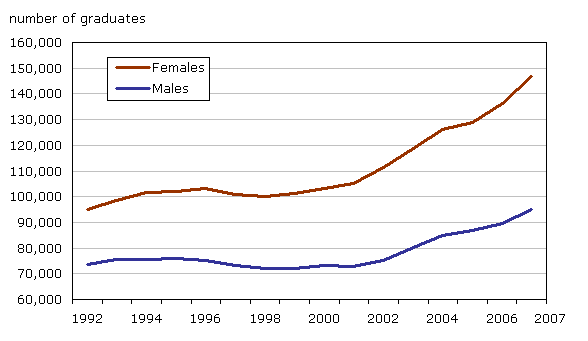
Source: Statistics Canada, Postsecondary Student Information System.
There are notable differences across the provinces in the gender trends in university graduation (Chart 2). British Columbia led the way, with strong growth in the number of both male and female university graduates between 1992 and 2007. Newfoundland and Labrador, Prince Edward Island, Ontario and Alberta saw strong growth in the number of female university graduates over the period. The percentage increase in the number of male graduates was weak in the four Atlantic Provinces, while Quebec saw very little growth in the number of either male or female university graduates.
That being said, female university graduates outnumbered males in every province in both 1992 and 2007.
Chart 2
Percentage change in the number of graduates between 1992 and 2007, by sex and province
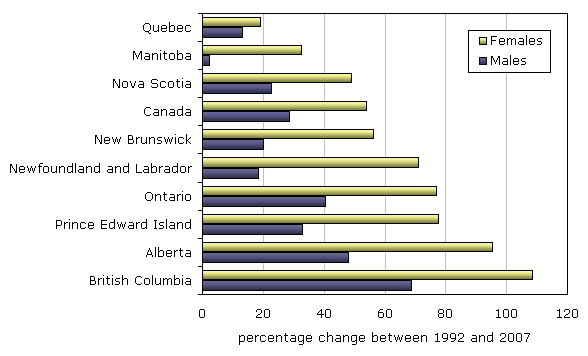
Note: Data for Saskatchewan are incomplete and are not shown.
Source: Statistics Canada, Postsecondary Student Information System.
Age profile of university graduates over time
The age profile of university graduates has remained relatively stable over time.
The ‘typical’ university graduate is between the ages of 22 and 24. The share of graduates accounted for by this age group has been fairly steady over time, at 44%, with a slight increase in this share in 1996 (Chart 3).
The share of graduates who were 25 to 29 years old has increased slightly over time. In 1992, 25 to 29 year-olds accounted for 22% of graduates; by 2001, their share had increased to 25% and that share held steady in 2007. In 1992, individuals aged 30 or more accounted for 25% of graduates, with this share holding relatively steady over time; in 2007, individuals aged 30 or more accounted for 23% of graduates. This means that just slightly less than half of all university graduates in 2007 were aged 25 years or more.
In 1992, 18 to 21 year-olds accounted for 8% of university graduates; this share decreased in 2001 when 6% of university graduates were between the ages of 18 and 21. By 2007, however, this share rose again to 8%, a reflection in part of the elimination of the final year of high school in Ontario in 2003 and a consequent increase in the number of young adults in the ‘double cohort’ graduating from university four years later, in 2007.
Chart 3
Age distribution of university graduates, Canada, 1992, 1996, 2001 and 2007
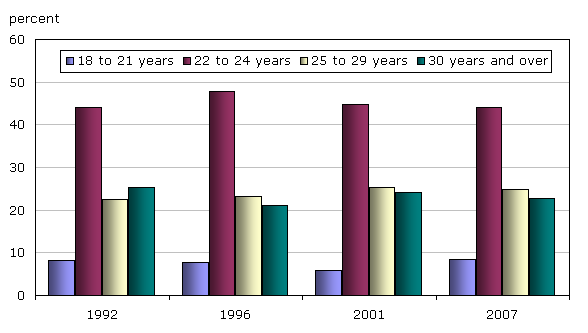
Source: Statistics Canada, Postsecondary Student Information System.
Rising share of international students
Prior to 2001, data on the number of international students graduating from Canadian universities were not collected consistently across the country and data for 2007 are currently being revised. As a result, the discussion of trends in international graduates as a share of total Canadian and international graduates focuses on the 2001 to 2006 period.
These data show strong growth in the share of graduates accounted for by international students, which rose from 4.7% in 2001 to 7.4% in 2006 at the national level. The gender distribution of graduating international students was stable between 2001 and 2006, with males accounting for about 54% of graduates and females, at about 46%.
Changes in the share of international students among university graduates have been very uneven across the provinces. In 2001, this share had a relatively narrow range, from 3.2% in Ontario to 7.0% in New Brunswick (Chart 4). The shares of international students were highest in New Brunswick, Nova Scotia, Quebec and Alberta.
Chart 4
International students as a share of Canadian and international graduates, Canada and provinces, 2001 and 2006
Note: Data for Saskatchewan are incomplete and are not shown.
Source: Statistics Canada, Postsecondary Student Information System.
By 2006, the picture with respect to international students as a share of university graduates had changed considerably. This share was highest in New Brunswick, at 11.5%, British Columbia, at 10.5%, and Nova Scotia, at 10.4%. Growth in this share was especially strong in the case of British Columbia between 2001 and 2006.
Trends in fields of study
Despite changes that have occurred in the characteristics of graduating students over time, there has been relatively little change in the overall composition of graduates’ fields of study. Three fields of study accounted for over half of all graduates in both 1992 and 2007–social and behavioural sciences, and law; business, management and public administration; and education (Chart 5).
Five fields of study saw slight gains in the share of graduates–business, management and public administration; health professions and related programs; architecture, engineering and related technologies; physical and life sciences; and visual and performing arts, and communications technologies. Other fields saw decreases in their shares of graduates–education; the humanities; social and behavioural sciences, and law; and mathematics, computer and information sciences.
Chart 5
Percentage distribution of university graduates, by field of study, 1992 and 2007
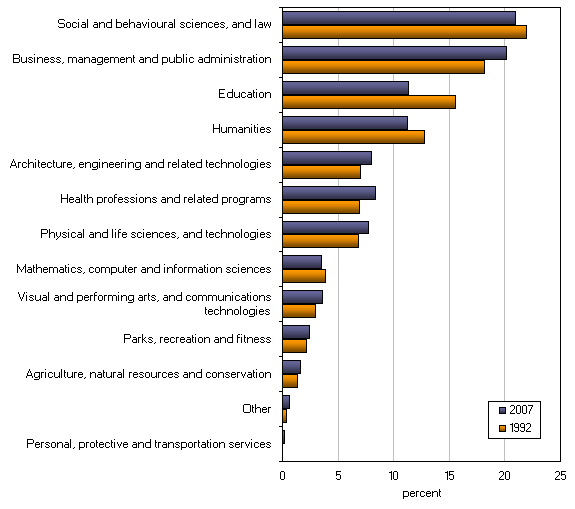
Source: Statistics Canada, Postsecondary Student Information System.
Changes were more pronounced when trends in fields of study of graduates are compared for women and men between 1992 and 2007 (Chart 6). Women accounted for the vast majority of university graduates in both 1992 and 2007 in fields of study related to health and education. Further, the female share has increased over time, especially in health, where their share of graduates reached 82% in 2007.
Chart 6
Female share of university graduates, by field of study, 1992 and 2007
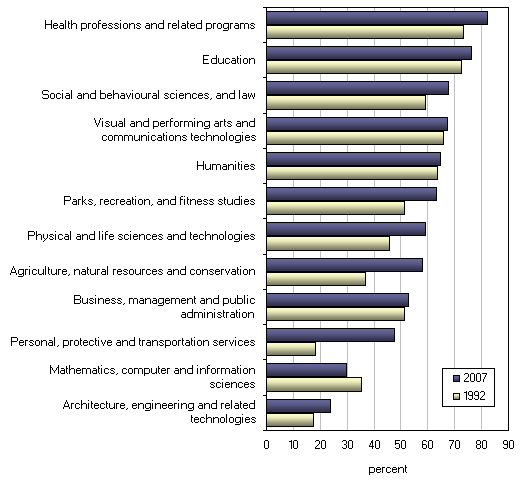
Source: Statistics Canada, Postsecondary Student Information System.
Women increased their share of graduates from less than 50% in 1992 to over 50% in 2007 in two fields–physical and life sciences; and agriculture, natural resources and conservation. In fact, women have increased their share of university graduates such that in 2007, they accounted for more than 50% of graduates in all fields, except for three: architecture and engineering; mathematics and computer sciences; and personal, protective and transportation services.
Only one field of study saw a decrease in the female share of graduates between 1992 and 2007–mathematics, computer sciences and information sciences. In fact, the number of both male and female students graduating with a university degree in mathematics, computer and information sciences decreased between 2004 and 2007, with the decrease being particularly marked for males (Chart 7). These decreases were offset to a certain extent by an increase in the number of graduates accounted for by international students, especially males.
Chart 7
Number of graduates, mathematics, computer and information sciences, by sex, 1992 to 2007
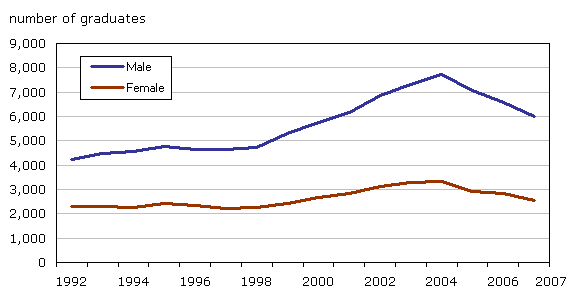
Source: Statistics Canada, Postsecondary Student Information System.
International students showed strong increases in their share of graduates between 2001 and 2006 in two fields of study in particular: in mathematics, computers, and information sciences and in business, management and public administration, the share of international students doubled between 2001 and 2006 (Chart 8). In 2006, international students accounted for 16% of graduates in mathematics, computer and information sciences; for 14% of graduates in business, management and public administration; and for 10.5% of graduates in architecture, engineering and related technologies.
Chart 8
International students as a share of university graduates, by field of study, 2001 and 2006
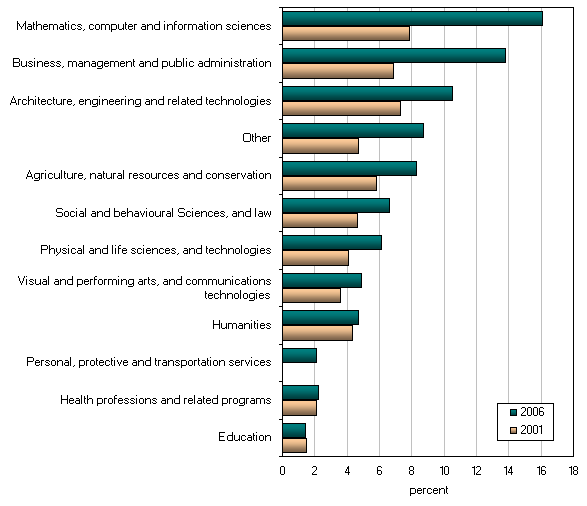
Source: Statistics Canada, Postsecondary Student Information System.
Conclusion
The number of students graduating from Canadian universities rose 43% between 1992 and 2007, increasing from 169,000 in 1992 to 242,000 in 2007. The number of both male and female graduates has grown steadily since 2002, following a period of stagnant growth in the mid-1990s.
That women outnumber men among university graduates is not new–that finding was already evident in 1992. However, the male-female gap has increased, especially during the most recent period of growth in the number of graduates, between 2002 and 2007.
Graduates from some fields of study have become almost exclusively female–in health and related clinical sciences and in education. In contrast, the decrease observed in the female share of graduates in mathematics, computer and information sciences reflects a long-term trend that has seen the share of females decline gradually over time. In fact, however, the number of graduates from this field accounted for by Canadian males has also dropped since 2004. These decreases in the overall number of graduates in mathematics, computer and information sciences have been offset by increases in the number of international students, especially males, graduating in this field of study.
Later in 2010, data from the Postsecondary Student Information System will become available up to 2008. Analysis of these data will help to determine if the patterns observed with respect to the gender, international student status and field of study characteristics of graduates from Canadian universities continue on their current trends.

